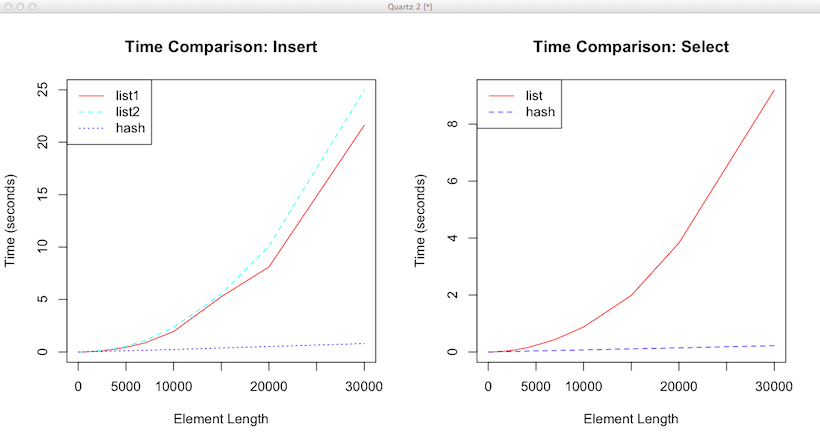R中媲美Python Dictionary的神器-hash
来源:互联网 发布:js删除数组里面空格 编辑:程序博客网 时间:2024/06/13 13:57
在Python中有这样一个神通广大的数据类型,它叫Dictionary。而长久以来在R中想要实现类似的Hash存储只能依靠environment类型,用起来非常不友好。
今天很偶然的发现了一个新的R包(其实也不新了,09年就已经发布,竟然一直没有发现)hash,它对environment进行了封装,使用户可以很方便的利用Hash表进行存储。
详细用法见文档
其中有几个地方需要特别注意的:
Hash表的Key必须为字符类型的,而且不能是空字符串
""引用传递。在R中environment和hash对象只存在一份全局拷贝,因此如果在函数内改变它的值将会影响到外部访问的结果。如果需要复制hash对象,需调用它的copy方法。
内存释放。通过rm销毁hash对象时,其占用的内存不会自动释放,因此需在rm前调用clear,以防内存泄露。
性能比较
hash对象的性能自然是没得说,下图是和list的一些比较。

左图是连续插入数据的时间,list1和list2分别表示两种向list中插入数据的方法;右图是通过指定Key的方式遍历整个对象所需的时间。从图中很明显的可以看到采用list对象无论是插入还是查找,性能随数据规模的增加下降非常明显。而hash对象的性能受数据规模影响非常小,近乎常数时间。
代码
见这里或者往下看。
# Encoding: utf8library(hash)list1.insert.test <- function(len) { a <- list() res <- system.time({ for(i in 1:len) a[[as.character(i)]] <- i }) res[3]}list2.insert.test <- function(len) { a <- list() res <- system.time({ for(i in 1:len) a <- c(a,i) names(a) <- 1:len }) res[3]}hash.insert.test <- function(len) { a <- hash() res <- system.time({ for(i in 1:len) a[[as.character(i)]] <- i }) clear(a) res[3]}list.select.test <- function(len) { a <- hash(1:len,1:len) b <- as.list(a) clear(a) x <- names(b) res <- system.time({ invisible(sapply(x, function(i) { b[[i]] })) }) res[3]}hash.select.test <- function(len) { a <- hash(1:len,1:len) x <- keys(a) res <- system.time({ invisible(sapply(x, function(i) { a[[i]] })) }) clear(a) res[3]}run.test <- function(fun, x, .progress='text') { require(plyr) laply(x,fun,.progress=.progress)}### ------ Main ------x <- c(10,100,200,300,400,500,600,800,1000,1500, 2000,3000,4000,5000,7000,10000,15000,20000,30000)list1.insert.time <- run.test(list1.insert.test, x)list2.insert.time <- run.test(list2.insert.test, x)hash.insert.time <- run.test(hash.insert.test, x)p <- par(mfrow=c(1,2))plot(x, list1.insert.time, type='l', col='red',lty=1, ylim=range(c(list1.insert.time,list2.insert.time,hash.insert.time)), main='Time Comparison: Insert', xlab='Element Length',ylab='Time (seconds)')lines(x, list2.insert.time, col='cyan', lty=2)lines(x, hash.insert.time, col='blue', lty=3)legend('topleft', c('list1','list2','hash'), col=c('red','cyan','blue'), lty=c(1,2,3))list.select.time <- run.test(list.select.test, x)hash.select.time <- run.test(hash.select.test, x)plot(x, list.select.time, type='l', col='red',lty=1, ylim=range(c(list.select.time,hash.select.time)), main='Time Comparison: Select', xlab='Element Length',ylab='Time (seconds)')lines(x, hash.select.time, col='blue', lty=2)legend('topleft', c('list','hash'), col=c('red','blue'), lty=c(1,2))par(p) 阅读全文
0 0
- R中媲美Python Dictionary的神器-hash
- Hash dump的神器----quarkspwdump
- dictionary的例子 python
- python dictionary的使用
- Hash破解神器:Hashcat的简单使用
- python 中List 与dictionary
- python中Dictionary、list、tuple的区别和联系
- python中字典和字符串的使用 dictionary string
- PyCharm中Dictionary与Python package的区别
- Python 取含dictionary的List中某一字段
- python中可hash的对象
- python中可hash的对象
- list<R>和 Dictionary<R>绑定数据源的实例
- AppleApp(1):TextMate--苹果中媲美Notepad++的文本编辑器
- STL中与快速排序媲美的merge sort
- python 中 r+string的用法
- python中%r和%s的区别
- python中%s和%r的区别
- 备忘录《一》基于cookie使用过滤器实现客户每次访问自登陆一次
- HTML关键字<7>
- 渲染管线—局部坐标到世界坐标的转换
- 2017可信云大会即将于7月在京召开!
- 如何解决广播中SD卡和开机自启动冲突的问题
- R中媲美Python Dictionary的神器-hash
- linux 时间戳
- JSON格式与string格式互相转换
- Guice入门实例和单例模式
- Java线程的sleep和interrupt方法测试
- Kinect V1结构光激光散斑原理及样式
- LeetCode 349. Intersection of Two Arrays
- 强大的Android控件之RecyclerView体验艺术般的控件
- 文件的原子操作


